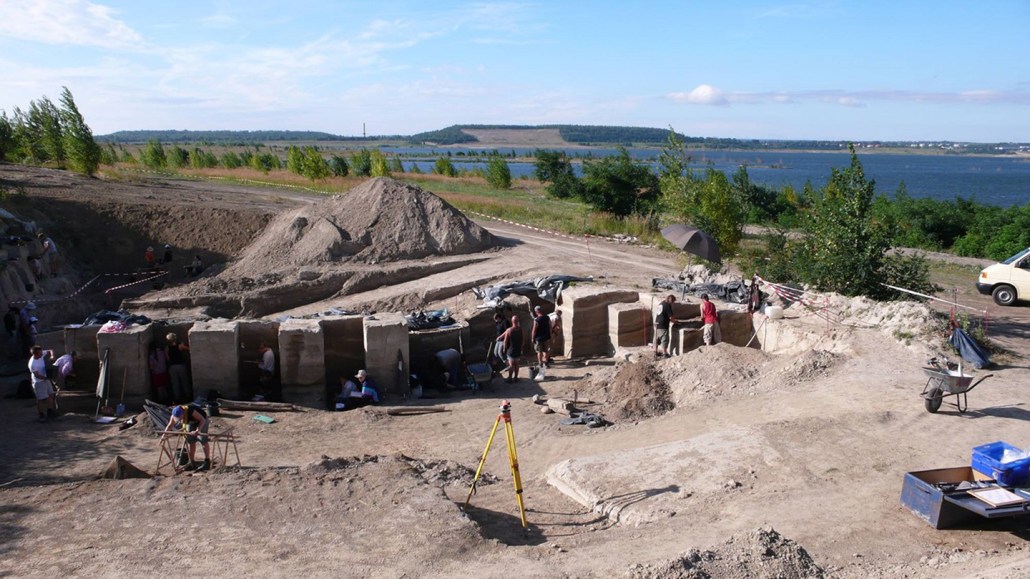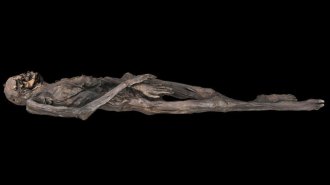Neandertals were the first hominids to turn forest into grassland 125,000 years ago
Neandertals’ campfires, hunting and other activities altered the land over a 2,000-year span

Two excavations at a German site, including the one shown here, produced evidence indicating that Neandertals’ campfires and other activities had transformed the local landscape from forested to largely open around 125,000 years ago.
Wil Roebroeks/Leiden University
Neandertals took Stone Age landscaping to a previously unrecognized level.
Around 125,000 years ago, these close human relatives transformed a largely forested area bordering two central European lakes into a relatively open landscape, say archaeologist Wil Roebroeks of Leiden University in the Netherlands, and his colleagues. Analyses of pollen, charcoal, animal fossils and other material previously unearthed at two ancient lake basins in Germany provide the oldest known evidence of hominids reshaping their environments, the scientists report December 15 in Science Advances.
The excavated areas are located within a site called Neumark-Nord. Neandertals’ daily activities there, apparently ongoing throughout the year, had a big environmental impact, the researchers suspect. Those pursuits, which occurred over a span of about 2,000 years, included setting campfires, butchering game, collecting wood, making tools and constructing shelters, they say.
“We might be dealing with larger and less mobile groups of [Neandertals] than commonly acknowledged,” Roebroeks says, thanks in part to warming temperatures after around 150,000 years ago that cleared ice sheets from resource-rich locations such as Neumark-Nord.
His team can’t say whether Neandertals set fires to clear large tracts of land at Neumark-Nord, a practice that has been observed among some modern hunter-gatherers. The geological remnants of many small campfires may look much like those of a small number of large fires, Roebroeks says.
Finds at Neumark-Nord play into an ongoing debate about when humans began to have a dominating influence on the natural world. Some scientists regard this period as a new geological epoch, the Anthropocene (SN: 4/1/13). It’s unclear when the Anthropocene began and whether its roots extend back to the Stone Age.
Regular fire use by members of the Homo genus began around 400,000 years ago (SN: 4/2/12). Evidence of human occupations associated with increased fire setting and shifts to open habitats date to around 40,000 years ago in Australia; 45,000 years ago in highland New Guinea; and 50,000 years ago in Borneo.
Analyses of lake cores and stone-tool sites in southern-central Africa indicate that fires set by increasing numbers of humans kept the landscape open even as rainy conditions conducive to forest growth developed around 85,000 years ago. Open environments still predominate in this part of Africa, Yale University paleoanthropologist Jessica Thompson and her colleagues reported May 5 in Science Advances. “Humans and close human relatives like Neandertals have likely been [modifying] their ecosystems for a very long time,” Thompson says.
A large coal mining operation revealed ancient Neumark-Nord sediments in 1985. German scientists then excavated a large lakeside site, wrapping up that project in the mid-1990s. The same team excavated a smaller site at a lake basin located about 100 meters from the first site between 2004 and 2008.
Pollen from these sites indicates that grasses and herbs, hallmarks of an open landscape, appeared in a brief window of time around 125,000 years ago, Roebroeks and his colleagues say. Large numbers of stone artifacts — some showing signs of having been heated, possibly to make finished edges sharper — and animal bones displaying butchery marks date to the same time at Neumark-Nord, when Neandertals but not Homo sapiens inhabited Europe.

Stone tools and bone fragments displaying signs of heating, burned wood, charred seeds and dense patches of charcoal particles suggested that Neandertals had frequently set fires near the Neumark-Nord lakes.
Pollen from two other sites in the same mountainous part of Germany, where researchers previously found small numbers of stone tools suggesting a limited Neandertal presence, show that forests dominated there when Neandertals inhabited Neumark-Nord’s grasslands. That strengthens the view that Neandertals altered the Neumark-Nord landscape rather than settling there after forests had shrunk, Roebroeks says.
Archaeologist Manuel Will of Eberhard Karls University of Tübingen in Germany agrees. “Neandertal evidence from Neumark-Nord should be a wake-up call for the international scientific community to include archaeologists [studying] the Paleolithic record as part of any team trying to define and identify the beginning of the Anthropocene,” says Will, who did not participate in the new study.







